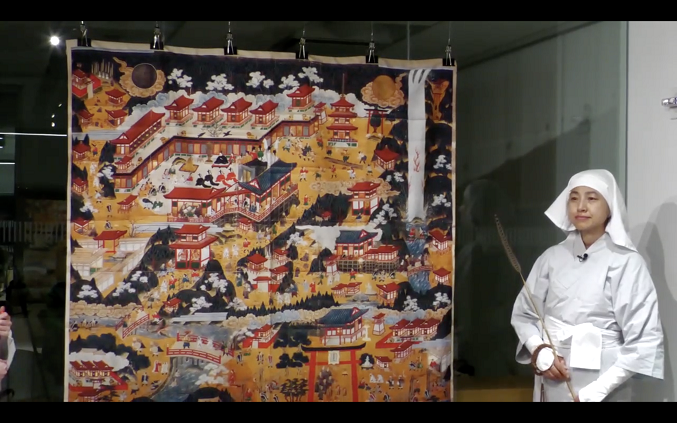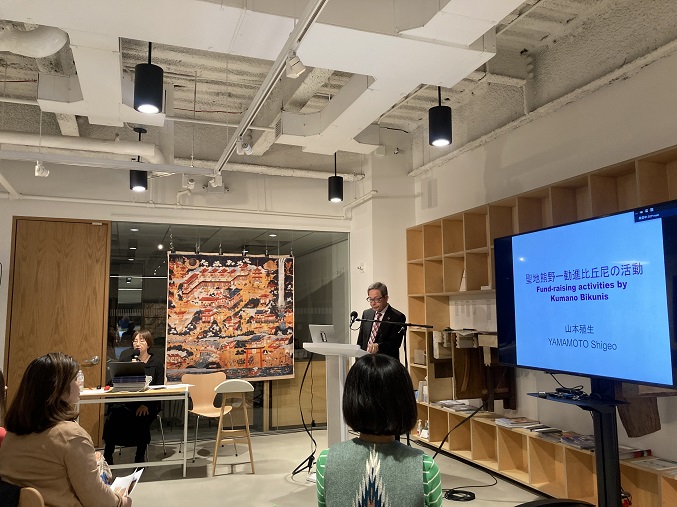“Invitation to Kumano: A Case of Regional Cooperation Applying Humanities by the University of Tokyo,” organized by the Graduate School of Humanities and Sociology, was held on Friday, March 17, 2023, at 6:00 p.m. EST at the UTokyoNY Office.
The University of Tokyo’s Graduate School of Humanities and Sociology and the Faculty of Letters signed a partnership agreement in 2021 with Shingu City, Wakayama Prefecture, the core city of the Kumano region. Some goals of this collaboration are, for example, to contribute to the cultural promotion and regional revitalization in the local community by applying humanities, to further develop Kumano studies, to let our students experience local culture in the Kumano region, to provide educational activities for junior and senior high school students in Shingu City. The Kumano region has been famous in Japan as a sacred site since ancient times. However, there have been difficulties in communicating its history, culture, and other attractions internationally in an academic way. This event was planned as a kick-off event for a collaborative project between Shingu City and our department to promote Kumano internationally as one of the most fertile fields for the Humanities.
Held onsite at the UTokyoNY office with simultaneous online streaming via Zoom, the event was attended by many people from the U.S., Japan, and other countries. More than one hundred people attended from all over the world.
The seminar was moderated by Professor Kaori Karasawa (Social Psychology) and began with an explanation of the purpose of the seminar titled “Introduction to the UTokyo Humanities Kumano Project” by then Dean Akira Akiyama (Art History). Professor Yukio Lippit (Harvard University, Japanese Art History), who has also studied at the University of Tokyo, then lectured “Invitation to Kumano.” Assistant Professor Izumi Ota Florence (Art History) then introduced the details of the project, “Invitation to Kumano -Activities of Regional Cooperation with Shingu City in Kumano,” which was followed by the research presentations in the second half of the session. Professor Teruaki Matsuzaki (Tokyo Kasei Gakuin Univ., History of Japanese Architecture) reported on the history of architecture and its restoration in Kumano under the title of “Construction and Repair of the Architecture of the Sacred Site of Kumano,” followed by a presentation by Shigeo Yamamoto (President of the International Kumano Society, Religious ethnology), gave a presentation, “Kumano, Sacred Sites in Japan: Fund Raising activities of Kumano bikuni”. Kumano bikuni were women who traveled around Japan in order to advertise Kumano since the Middle Ages. After a short break, Ms. Midori Ikuma(Kumano Nachi Guide Association) gave a re-enactment of the storytelling ritual, E-toki, of the painting “Nachi Sankei Mandala (Nachi pilgrimage map mandala)” in the costume of Kumano bikuni.
The lineup of this seminar, which included some introduction to the history and culture of Kumano and the UTokyo Humanities Kumano Project, as well as a re-enactment of the pictorial interpretation, made the seminar easy to understand in terms of content and visually enjoyable for both the American and Japanese participants. The Q&A session at the end of the seminar was very lively, and even at the reception following, various topics were discussed, such as the attractive points of Kumano and comparisons of examples of religious culture in Japan and in other countries.
The seminar was a great success, thanks to the cooperation of people in Shingu City, Wakayama Prefecture, and our university, and above all, to all those who attended and showed interest in the seminar. We would like to express our sincere gratitude.



